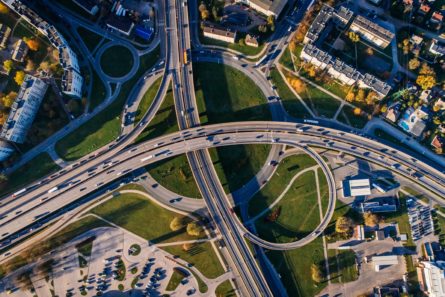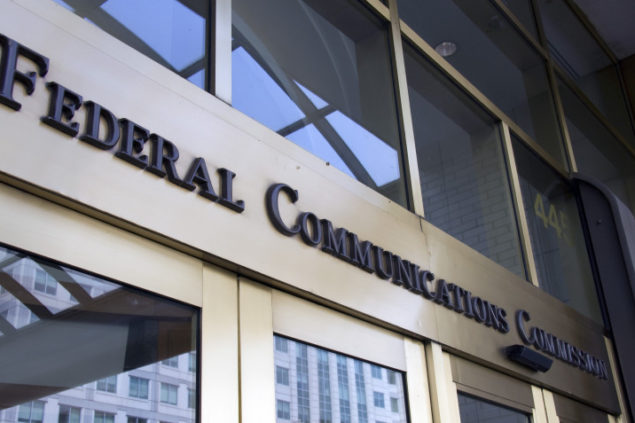Tech Roundup Episode 13 – Autonomous Vehicles: Where Are We Now?

Experts Marc Scribner and Adam Thierer join us to provide an update on autonomous vehicle (AV) policy. Why has Congress been unable to pass significant AV legislation? How have the Department of Transportation and state governments filled that void? What are the best and worst examples of how governments should approach AVs?
Related Reading:
Transcript
Although this transcript is largely accurate, in some cases it could be incomplete or inaccurate due to inaudible passages or transcription errors.
[Music and Narration]
Introduction: Welcome to the Regulatory Transparency Project’s Fourth Branch podcast series. All expressions of opinion are those of the speaker.
Jack Derwin: Welcome to the Regulatory Transparency Project’s Tech Roundup podcast, part of RTP’s Fourth Branch podcast series. My name is Jack Derwin, and I’m Assistant Director of RTP at The Federalist Society. Today, I’m excited to be joined by Marc Scribner and Adam Thierer to discuss the latest in autonomous vehicle policy.
Marc is a Senior Transportation Policy Analyst at Reason Foundation, where his work focuses on transportation, land use, and urban growth.
And, Adam Thierer, our moderator today, is a Senior Research Fellow at the Mercatus Center at George Mason University. He specializes in innovation, entrepreneurialism, and the Internet.
Thank you so much for joining us today.
Adam Thierer: Thanks for having us.
Marc Scribner: Thank you for having us.
Jack Derwin: Of course. And with that, Adam, I’ll pass things over to you.
Adam Thierer: Well, thank you, Jack, and I am really excited to be joined here by Marc Scribner today. For many years now, Marc has been my go-to source for all things planes, trains, and automobiles related. He’s really one of the nation’s leading experts on emerging transportation technologies, whether on the ground or in the sky, so I’m excited about our conversation today. And what we’re going to try to do is bring our listeners up to speed with what’s been happening on the autonomous vehicle front in recent years.
Marc has recently authored a piece that I saw on Congress’s failure to enact an automated vehicle regulatory framework is an opportunity for the states. And this built on two really excellent studies that Marc did having to do with challenges and opportunities for federal automated vehicle policy, as well as another big study on ten best practices for state automated vehicle policy.
So, Marc, with that, let me turn to you, and ask you to kick off our conversation by asking you to take a step back, and help our listeners understand how we got to the point we find ourselves in today, which is America still stands in a position where we have no clear national policy framework for autonomous vehicle systems.
And I remember when the two of us started covering this issue––gosh, I think it’s been almost a decade now––we were writing about it during the Obama years. And shortly after that, bills started to be introduced in Congress––AV START, SELF DRIVE Act, and others––and the consensus was that something was going to happen. I think I even believed that for a time. And everybody else thought it would be a slam dunk. But here we are now in 2022, and many years and several sessions of Congress have passed, and yet, we still don’t have a national policy framework for driverless cars. So, Marc, why can’t Congress get AV legislation over the goal line?
Marc Scribner: Well, that’s a great question, Adam. And, as you said, there was a lot of momentum several years ago when the 115th Congress in 2017-2018, there really seemed like something was going to happen. As you said, we had, maybe, a slam dunk, definitely in the House. The SELF DRIVE Act passed by voice vote, and then it ran into problems in the Senate with the companion bill. And it really doesn’t seem to have much to do with policy differences. And in speaking with staff on both sides of the aisle, I think everyone sort of understands what needs to get done, what are the high priority items, what can be done today, given the state of technical standardization, just general knowledge of the technology.
But it’s emerged — there are a few interest groups who are very much opposed to some of the potential outcomes that they see with these bills. Namely, you’ve got unions who are concerned about lost driver jobs in the future if this technology impacts the labor market as most people expect it eventually will. And then you have trial lawyers who have made shifting demands, but one thing they’ve definitely wanted over time is an explicit prohibition on arbitration clauses in future customer contracts. So no one’s really written these contracts yet because we don’t really have deployment of this technology, certainly not at scale.
But those are the two main interest groups that have held this up. So it’s really — it’s less policy; it’s more politics right now. And we’ve been at this impasse since the 115th Congress. And right now, the current make-up of Congress, this doesn’t seem to be a priority, so probably not this Congress. Maybe next Congress we’re going to see some movement on this, but I’m not holding my breath.
Adam Thierer: So this is astonishing to me. And I note that last May a top official from the AFLCIO testified in front of Congress and told them that driverless trucks “place millions of jobs at risk,” and he demanded that Congress exempt trucks from any legislation having to do with self-driving vehicles. I found that kind of astonishing, given that, in the same breath, he was talking about a nationwide shortage of drivers.
And then, second of all, there’s been an ongoing push for road safety in this and other administrations. And, of course, truck safety is first among those issues because of the huge toll that accidents take on the nation’s interstate highway system in terms of truck accidents.
So it just doesn’t seem to make any sense. It doesn’t add up, and yet, still, that interest and the trial lawyers seem to be blocking advancement of it. And correct me if I’m wrong, is there even legislation moving at all anymore in Congress? I think one of the two bills was introduced, but I don’t know if the other one was. Is that right?
Marc Scribner: Yeah, there was, briefly. There’s been some sort of half-hearted symbolic efforts to basically reintroduce what was introduced a few years ago. There was a serious effort that never got off the ground to do what they were calling a skinny AV bill that focused on fewer matters than the AV START and SELF DRIVE Acts from the 115th Congress did. But nothing has happened on that.
The last big opportunity would have been surface transportation reauthorization, which was included as part of the Infrastructure Investment and Jobs Act, the big infrastructure law. But that, it didn’t make into the safety title there either. Right now, it’s really — we’re going to probably have to see a new Congress and really some — to shake things up and see what happens because the areas — the logical vehicles, legislative vehicles where you would expect to see this kind of legislation, we’ve passed them by.
Adam Thierer: In light of that, let’s talk about what’s happened in the regulatory environment, then, and stay focused, for the moment, at the federal level. And I want to ask you a two-part question about what’s been happening at the Department of Transportation over the past few years in light of this sort of legislative vacuum in Congress.
For better or for worse, at the DOT we’ve seen a lot of so called soft-law guidances and announcements to fill the governance gap left by congressional inaction. So one part of the question I’d have to you is, when you highlight what’s been happening at DOT, to talk about for better or for worse the rise of soft law as a governance norm for AVs.
And then second is this question about a lot of people have been hinting that the Biden administration is going to get tough with a lot of AV makers and companies, and with one company and innovator in particular, and that would be Elon Musk and Tesla. And so there’s been a lot of chatter recently about that because one of Musk’s biggest critics was appointed to a position at NHTSA within the Department of Transportation. And so maybe the Biden administration is going to take a different path than the Obama and Trump—especially Trump—did with the more soft law, informal pronouncements. So answer that two-part question about what’s been happening in the regulatory community.
Marc Scribner: You’re absolutely right. And you’ve written a lot on the subject of soft law and how it applies to AVs, particularly at the federal level. And I see that persisting for at least a bit longer just because if you look at the rule-making pipeline, if you look at the uniform agenda of regulatory and deregulatory actions, you see some future activities on the horizon, most notably on occupant protection for automated driving systems, equipped vehicles, that was basically fully baked at the end of the Trump administration, and then it was subject to additional review for the last year. That looks like it may be coming out in — it’s scheduled February 2022. So that would be the first thing to potentially move, and what that would do, is it would update an existing regulation that would allow some novel vehicle types.
There’s a company called Nuro, for instance, that proposes to do last-mile delivery with a small vehicle that you wouldn’t even have a person driving it or riding in it ever, so it shouldn’t be subject to the kinds of occupant protection requirements that a passenger vehicle would be.
So those are the kind of regulatory housekeeping things we eventually want the National Highway Traffic Safety Administration to get through, and we might be seeing that soon. But as you’ve written about soft law, the guidance documents that have basically made up what federal automated vehicle policy is since 2013, the Obama administration, that’s — we’re likely to see that a bit further.
On the question of is the Biden administration going to get tough, maybe. But what that means, is it going to get uniformly tough? That, I think, remains to be seen, even if they do get tough, because, as you mentioned, Elon Musk and Tesla have been very controversial in this space.
Tesla is unique among automated vehicle developers in that it is not doing the — it’s rolling out progressively higher levels of automation—or at least, that’s its plan—to end consumers, whereas all the other developers are basically focused on much more controlled testing with fleet vehicles, whether that’s for freight or passenger. Think Waymo, formerly known as the Google self-driving car project, or the efforts by major auto makers like Aurora and Ford and GM Cruz, who tend to be — although, there was some recent announcements from GM that that may be changing. But, by and large, those are much more controlled releases of higher automation technology, not phasing in from an advanced driver assistance system, which is what Tesla’s been doing.
You mentioned that the appointment of Missy Cummings as a senior advisor at the National Highway Safety Administration, she has been very critical of Tesla’s approach but hardly alone in that criticism. Like I said, her position is not much different from every other auto maker or developer of this technology. But I think we have seen — the most concrete action was summer 2021. We saw NHTSA put out a standing general order, which is a pre-enforcement action, to collect data on crashes involving automated vehicles.
And the thing is, it didn’t just focus on Tesla where there had been some notable crashes and fatal crashes involving or potentially involving auto pilot, Tesla auto pilot being engaged at the time of the crash. It covered all automated vehicles, including those companies that are testing this on public roads with safety drivers or in otherwise much more controlled settings.
And I think that you saw the tension that had been growing between Tesla and everyone else in the auto industry boil over because now they are subject to this reporting requirement that likely is 90% aimed at Tesla and probably would not have been issued if not for Tesla’s behavior. So there’s definitely some — not a lot of happiness among Tesla’s competitors right now, and we’re seeing that.
So it’s an interesting dynamic because, like I said, it’s Tesla versus the world right now. So you may even see some of those traditional automakers or other developers acquiesce if not support more hard law regulation.
Adam Thierer: Yeah. So let me ask you a question I got just recently when I was talking to some law students, and several of them were Federalist Society members. I was asked—when I was talking about these issues—by one student, how is it that Tesla gets away with this? Why aren’t they in violation of federal motor vehicle safety standards? And they’re just behaving — sort of going around the system. It’s what I call in my most recent book evasive entrepreneurialism. They’re actively evading or, at least kind of steering clear—excuse the pun—from traditional regulatory requirements. Is that accurate, and if it is accurate, how is that working? How is that playing out?
Marc Scribner: Well, the United States is somewhat unique in how its—compared to the rest of the world, anyway—in how its auto safety regulatory system works in that it depends on self-certification to minimum safety and performance standards. Much of the world, our peer countries in Europe and Asia, and, really, everywhere except North America, by and large, they have a regime called type certification, which is basically pre-market approval. So you a have an auto safety regulator pull a production vehicle off the line and ensure that it meets these requirements. Here, you have manufacturers, parts suppliers, basically, saying they meet these minimum requirements. And as long as they are not making required safety features inoperative, they’re in compliance.
Now, Tesla has done certain things where you’ve seen recalls recently over the — they had a game in their center console screen, which is probably not a great idea and potentially pushed them out of compliance. But, for better or for worse, that’s how our regulatory system works, and I’m inclined to think it’s generally better because it allows for much more experimentation than would be the case under a type approval regime. But, at the same time —
Adam Thierer: — You should point out that it’s bolstered by a recall regime if things are found to go wrong.
Marc Scribner: Absolutely. There are still — yes, the National Highway Traffic Safety Administration has robust enforcement powers, as we said, even if they suspect somethings up. That standing general order I mentioned was pretty bizarre. The last time NHTSA has used that, they did in a much more methodical way, and it was with the Takata airbags that were exploding, which was a much more serious hazard at the time.
NHTSA has quite a bit of latitude in its pretty expansive enforcement powers. Sometimes, people are saying that NHTSA’s hands are tied here. I don’t think that’s the case at all, but they do have to show that there is good cause for them to bring enforcement actions. And, maybe, we will see — they’re currently — the investigation is underway. There’s multi parts to this investigation now. Maybe we’ll see more enforcement actions. But the fact that they have to go through some procedural hoops is a feature, not a bug.
Adam Thierer: Right. So that’s a good overview what’s happening at the federal level, or maybe isn’t happening at the federal level. And given that we do have a bit of a continuing legislative vacuum and sort of a piecemeal approach at the DOT, a lot of the action has shifted to the states. And you wrote about this recently in a major report and talked about the resulting state efforts that we’re seeing play out.
I want to ask you about what best practices should guide, or are guiding already, the development of AV policy at the state level. The Federalist Society has always been very actively involved in pushing for potential devolution or federalism-based solutions where possible. And I can see upside here, but I can also see some downside. Why don’t you give us an overview of what’s happening, and also, as you do so, maybe the best of what’s happening and the worst of what’s happening.
Marc Scribner: Sure. So the auto safety regulation, we generally think of the 70 federal motor vehicle safety standards that the National Highway Traffic Safety Administration administers, but the states play a very important role in the regulation of motor vehicles and long have. States are the ones who are responsible for registration, for driver licensing, for liability determination, and insurance. All of those things play a big role in how vehicles operate and, ultimately, are used in society. So the states definitely have a role.
My general approach is for those traditional divisions of responsibilities between the various levels of government, basically keep those the same. Don’t need to reinvent the wheel here. States are very good at certain aspects, and the federal government is very good at certain aspects. And those two should not switch places, in my view.
I’ve made a number of recommendations, and in the report you mentioned, I have ten. I’ve shortened that to four, what I think are the most important of those ten. And number one is adopt a standard vocabulary, by which I mean use standard definitions from SAE International, formerly the Society of Automotive Engineers. And the purpose of that standard and to use those terms is to ensure that lawyers and engineers can talk to each other and are mutually intelligible.
Number two is a very, very important housekeeping item. But states have pretty extensive motor vehicle codes, a lot of which mirror existing federal requirements. So there’s a potential for some conflict there over time. But really, what states need to do, just like the feds have done in recent years, is to audit those equipment codes, vehicle codes, for potential conflicts with automated driving systems. Some of them are specific to automated driving systems.
If you’ve got an occupantless last-mile delivery vehicle, fully automated where you can’t have someone seated there, you probably shouldn’t have a requirement for pedals, for steering wheels, for seatbelts, all of those sorts of things. But even electric vehicles, a lot of state codes have muffler requirements which don’t make a lot of sense in the context of an EV, automated or not. So doing those kinds of things.
And we’ve seen Florida, so far, is the only state that has actually attempted to address that problem by basically enacting a law that said, “If these requirements don’t make sense in the context of an automated vehicle, well, they don’t apply.” I think further on, you’re going to probably want to better develop that, be a bit more specific. But I think that suits its purpose for now.
The third, I would say, distinguish between vehicle types. A multi-ton highway vehicle SUV has a very different risk profile than what is basically a golf cart, and that’s what Nuro’s last-mile delivery vehicles are. They’re classified as a low-speed vehicle under federal law. Florida’s also taken the lead on that issue. Last year, they created a new regulatory class called low-speed autonomous delivery vehicle that allowed for these non-occupied AVs weighing less than 3,000 pounds and travelling under 25 miles an hour to be subject to fewer requirements than is generally required of highway vehicles.
And then, the last of the four is avoiding questionable legal frameworks. When it comes to — for soft law, for instance, I think that serves a very valuable purpose in the interim before policy makers can figure out how to actually modernize their vehicle codes, or whatever, to accommodate these new technologies. But you saw some states, I think, getting a little cute with that, taking guidance documents, taking executive orders, and using those in place of regulation and legislation, binding private parties, compelling them to do certain things, which is not the purpose of those tools.
I much prefer that if you’re going to force people to do something that you go through the proper channels for that of traditional legislation and regulation. And you’ve seen a state where — Arizona, for instance, stood up their regime, their initial automated vehicle regime, through executive orders. Well, last year they basically codified that whole thing, and the legislature signed off on it. Those are the kinds of practical steps that I think can be taken immediately.
Adam Thierer: You mentioned some of the more enlightened approaches, Florida, maybe Texas, maybe now Arizona. I think you, in your report, talked about Georgia doing some interesting things. But tell us briefly just a few states—and I’m just going to just go ahead and throw them out there for you because I know you do highlight them in your report—that are doing maybe some boneheaded things. And I’m thinking New York and California. And then also tell us what that’s meant for the market because, clearly, New York and especially California can really drive national policy in a big way, given the scale of their markets. So tell us about what’s happening there briefly.
Marc Scribner: New York was a unique situation because they had a very unique vehicle code that required one hand or prosthetic device to be on the steering wheel at all times during operation. So that posed some unique challenges that I don’t think the authors of that law had foreseen when they put that into the code years ago. New York was always an interesting case, but they’ve done things like they’re letting New York City drive too much of the policy discussion there. And they’re not being as welcoming as they could, in part because I think they have concerns with—and perhaps unique and legitimate concerns—with the higher densities of Manhattan. But I think there’s some protectionism going on there that is all too common in that state requiring testing on public roads with restrictions that you don’t even see in California.
And then to the California point, I think they are well-meaning. I will say that because they were first movers on this in attempting to regulate this technology to explicitly authorize testing, had strong endorsements. They signed the original AV legislation into law back in 2012 at Google headquarters with the founders looking on. So I think there’s some well-meaning people there, but I think they’ve gone too far in excessive regulation without necessarily paying attention to unintended consequences.
One example would be their disengagement reporting requirement. Any time the automated driving system in one of these vehicles that’s operating on the roads disengages, they’ve got to log that and provide that information to the state, which is then made publicly available. And the problem with that is—and especially because it’s publicly available—it provides some bad incentives. If you want to have a low disengagement rate, what do you do? You do all the easy testing. You go to places where you have wide open roads in the suburbs, perhaps, rather than downtown San Francisco where you have those trickier edge cases where you really want to get a handle on those before you actually start doing wider-scale deployment.
And, frankly, at least, if you’re looking at potential business models, the taxi style AVs remains one of the most promising, and that has disproportionate value in dense urban cores as opposed to suburbs and exurbs, let alone rural areas. I don’t think it was poorly intentioned there, but you know what they say about the good intentions and the roads they pave.
Adam Thierer: They only get you so far. Related to that, you do mention that some innovators have moved, innovation arbitrage has kicked in and moving around, at least, out of California. Anybody, in particular, whose — I mean, Tesla, anybody else?
Marc Scribner: Well, you did see a lot of testing. Now, some of them have moved back into California, and they’re doing some testing. But that’s why you saw a lot of the growth in testing and early deployment in the Phoenix East Valley in Arizona. These are California-based companies. You’re seeing a lot of — you mentioned Texas. Texas is another light-touch state. That’s where you’re seeing long-haul trucking technologies being tested.
Now, part of that is the weather makes those suitable test grounds. They don’t have to deal with snow or, really, any form of precipitation. But certainly, the welcoming regulatory environment played a role, and that’s why you really see the — Phoenix East Valley is still really the only place where you can hail a fully self-driving vehicle and use it like a ride hailing car.
Adam Thierer: Marc, speaking of a welcoming regulatory environment, I want to ask you to close on this point because we’ve only got a few minutes left. We’ve talked about the federal level. We’ve talked about the state level. But, of course, cars are a global business, and there are a lot of places to develop cars and a lot of great innovators across the globe. So capital often flocks to where it’s treated most hospitably, and innovation can too.
Are there any other models in any other countries that are ahead of America’s, that are better than America’s, conversely, that are radically worse? How will this play out? And I ask you to say this in just the few short minutes we have left.
Marc Scribner: I would say we’ve seen more national activity. Particularly, U.K., Germany have been much more active on national regulatory frameworks than the United States is. However, I don’t necessarily think that they are in a better position because, like I mentioned, the U.S. and North America’s pretty unique that we have our self-certification regime. And while the kind of type approval or pre-market approval might — there could be benefits there for developers in that it tends to provide a better liability shield than our federal self-certification auto safety regime, but that’s about it.
I think the self-certification is generally preferable. But if Congress doesn’t act, and we see more and more countries moving and taking the concrete steps that need to be taken in order to fully integrate these technologies into our auto safety regulatory ecosystems, I think you will, longer term, see more attention shift abroad.
Adam Thierer: Great. Well, that’s about all we have time for today on today’s show, but before we close, I want to encourage all of our listeners to subscribe to this podcast on whatever podcasting platform they most enjoy. And I want to ask all of you to follow Marc on social media. Marc, where’s the best place for people to find you online?
Marc Scribner: You can find me at reason.org and then on Twitter @marcscribner. You can find me there regularly tweeting about automation and other transportation issues.
Adam Thierer: Indeed, I encourage all of our listeners to follow Marc. He’s a fount of knowledge on this front and will continue this conversation there.
Marc, thank you so much for joining me today. I really appreciate it.
Marc Scribner: Well, thank you so much for having me, Adam.
Adam Thierer: Yeah, and I’ll turn it back to Jack to close things out.
Jack Derwin: Well, thank you both so much for joining us today. I think our listeners will really appreciate the update on this really interesting space. And, Adam, where can our listeners find you on Twitter and elsewhere?
Adam Thierer: They can find me on Twitter @AdamThierer. And, of course, they can go to the Mercatus website and find all my related writings there.
Jack Derwin: Great. And thank you to our audience for tuning in to this episode of RTP’s Tech Roundup podcast. As Adam noted, you can subscribe on any major podcast platform, and check out our website, regproject.org, or our social media accounts @FedSocRTP to learn more. Thank you.
[Music]
Conclusion: On behalf of The Federalist Society’s Regulatory Transparency Project, thanks for tuning in to the Fourth Branch podcast. To catch every new episode when it’s released, you can subscribe on Apple Podcasts, Google Play, and Spreaker. For the latest from RTP, please visit our website at www.regproject.org.
[Music]
This has been a FedSoc audio production.

Topic
The Federalist Society and Regulatory Transparency Project take no position on particular legal or public policy matters. All expressions of opinion are those of the speaker(s). To join the debate, please email us at [email protected].









